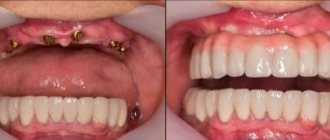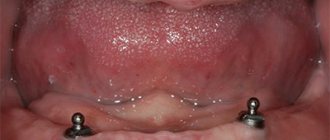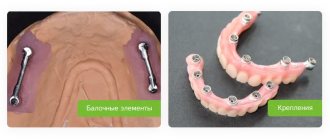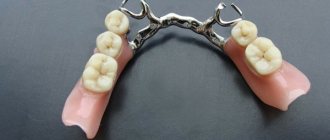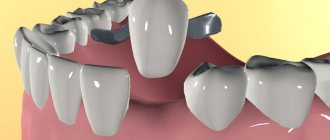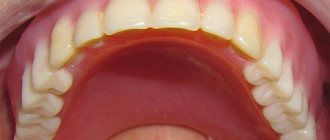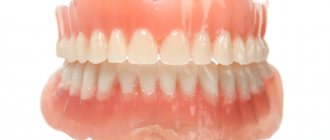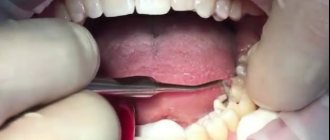From this article you will learn:
- how to improve the fixation of complete removable dentures,
- types of overdentures, reviews,
- price for 2022.
Conditionally removable (covering) dentures are a type of dental prosthetics in the complete absence of teeth, when several dental implants are installed under a removable denture in order to improve its fixation on a toothless jaw. Fixation of such prostheses to implants installed in the bone tissue of the jaws is carried out using special locking fasteners. Such attachments can be push-button or bar-type, for example, through ball-shaped abutments, Locator® equatorial abutments, and cast or milled bars (Fig. 1-3).
Dentures of this type are called “conditionally removable” in dentistry for the reason that you can only remove such a denture if you apply sufficient force. However, patients more often call them by the term “overdentures”. Their biggest advantage is that they never fall off while talking or chewing. It should also be noted that dentures of this type can be used not only with complete, but also sometimes with partial absence of teeth.
Conditionally removable prosthesis: photo
* The minimum cost of a conditionally removable prosthesis on implants will start from 100,000 rubles (detailed options for prostheses and prices - see below).
Advantages of conditionally removable dentures –
Traditional removable dentures made of ordinary acrylic plastic are very poorly fixed on toothless jaws. This is due to the fact that under removable dentures, atrophy of the alveolar processes of the jaws (on which the denture “sits”) gradually occurs. This leads to a gradual decrease in the height and width of the alveolar processes - in proportion to this, the fixation of the prosthesis worsens.
Advantages of dentures on implants -
- excellent fixation even with severe bone atrophy,
- immediate prosthetics,
- comfort - such dentures have a smaller plastic base (on the upper jaw the denture is made with virtually no overlap of the palate),
- relatively affordable price.
Conditionally removable prosthesis on implants: reviews
We have already said above that conditionally removable dentures on implants are fixed using special locking fasteners. Half of each such lock is screwed into the implants and protrudes above the surface of the gum mucosa, and the second half is installed in the base of the denture (in the projection of the installed implants).
When putting on the prosthesis, the parts of the locking fasteners are connected and the prosthesis is securely held. To then remove such a prosthesis, you need to apply a force equal to an approximate lifting of a mass from 400 to 2000 grams (depending on the type of attachment). An overdenture can have several types of fixation to implants, which we will describe in detail below...
Prostheses with push-button fixation –
At the first stage, implants are installed in the jaw, the number of which will depend both on their diameter and on whether prosthetics will be performed on the upper or lower jaw. In the upper jaw, 4 implants are usually installed - regardless of their diameter, which is due to the presence of a softer type of bone in the upper jaw.
On the lower jaw, if mini-implants (1.8-2.4 mm in diameter) are used, 4 of them are also installed. Moreover, the use of implants of such a small diameter allows you to almost always avoid bone grafting - if the patient has thin alveolar shoot. However, if implants with a diameter of 4-5 mm are used, only 2 of them can be installed, but 3-4 are still better, because this will improve the stability of the prosthesis.
Prosthesis fixation system - after installing the implants, abutments are screwed into them, which will protrude above the surface of the mucous membrane and serve as an element for fixing the prosthesis. For these purposes, two types of abutments can be used: spherical or equatorial. Which type of fixation (using which abutments) is better – we explain in detail below.
1) Fixation on ball-shaped abutments –
Below we show a diagram of fixing a removable denture on ball-type abutments. You will find a detailed description below.
After installing the implants, abutments are screwed into them (or the implants may already have permanent abutments). Externally, the spherical abutment looks like a metal ball-shaped head protruding above the mucous membrane (Fig. 4). Such spherical abutments are the first half of the mechanism for fixing a removable denture on implants. The second half of the locking fastening is located in the base of the prosthesis.
In the projection of each implant with a spherical abutment, a recess is made in the base of the prosthesis into which a metal holder for a silicone matrix is inserted, of course, along with the matrix itself. The silicone matrix is something like a rubber sealing ring (Fig. 5). When putting on the prosthesis, the head of the ball-shaped abutment passes through this ring, which then tightly holds the abutment (Fig. 6). After this, the prosthesis can be removed only by applying sufficient force.
Fixation of the prosthesis on ball-shaped abutments: photo
Important: the big disadvantage of the fixation system on ball-shaped abutments is that they tend to wear out as a result of friction in about 2-3 years. As a result, the abutment head becomes flatter and the silicone matrix holds it less and less well. That is why it is worth installing only those implants in which the ball-shaped abutment can be replaced with a new one.
If you install implants that already have permanent abutments, then in order to replace them, you will simply have to install the implants again. To reduce the rate of wear, some companies coat the abutments with special coatings, but this is still not a long-term solution to this problem.
2) Fixation on equatorial abutments (Locator®) –
This fixation system is called Locator® (Fig. 13-15).
For patients, it is more comfortable in terms of removing and putting on a removable denture, and also allows them to visit the dentist less often to service the prosthesis fixation system. It allows implant surgeons to place implants in the jaw at large angles relative to each other, which is necessary in case of severe atrophy of the jaw bone tissue. Equator abutments differ from spherical abutments in their shape, which affects the nature of the interaction between the abutment and the silicone matrix. With this system, a holder for the matrix is also built into the base of the removable denture (along with the silicone matrix itself) - in the projection of each installed implant with an abutment. Equator abutment dentures are more comfortable and require less maintenance.
Fixation of the prosthesis on the equatorial abdomen: photo
Features of prosthetics with prostheses with push-button type of fixation –
The manufacture of a prosthesis, both when using spherical and equatorial abutments, in most cases can be carried out immediately after surgery (especially on the lower jaw). Those. Impressions will be taken immediately and within a few days a prosthesis will be made from either regular acrylic plastic or slightly elastic Acry-free material (this option will be more expensive).
However, if you already have a prosthesis (provided that it is well made and is no more than 2 years old), you will be able to use your old prosthesis without making a new one. To do this, recesses will be made in your old prosthesis and locking fasteners - silicone matrices - will be installed there.
Advantages of push-button type fixation:
- technical ease of manufacture,
- more affordable price,
- implants with push-button fastening can be installed even under an old prosthesis,
- simpler hygiene (less risk of inflammation around implants in the future).
Disadvantages of push-button type locking –
- Weakening of the fixation over time requires periodic replacement of silicone matrices, and in the case of spherical abutments, the matrices will have to be changed several times more often - approximately once every six months (compared to the use of equatorial abutments, where the matrices are changed less frequently).
Overdentures with fixation “Locator”: video
What are the alternatives?
If we talk specifically about conditionally removable prosthetics on a beam, then a more reliable and durable alternative may be a “reinforced” structure installed according to a one-stage treatment protocol. A more budget-friendly alternative would be to install a removable model supported by mini-implants. There are also options for conditionally removable prosthetics with ball-shaped fastening on implants and using the Locator system on equatorial-type abutments. In the first case, the orthopedic device will last a maximum of 2-3 years, after which the product will have to be replaced. The Locator system is more reliable and durable, however, it is also inferior in efficiency to single-stage implantation with fixation of an orthopedic device with a beam using the screw method.
Bar prosthesis on implants –
Covering dentures on implants in the absence of teeth can have not only a push-button type of fixation. In this case, the prosthesis can be fixed on a metal beam secured to 2-4 implants. A recess will be made in the plastic base of the removable denture (corresponding to the size and shape of the metal beam), and silicone holders will be inserted there.
Beam prosthesis on implants: photo
Important: in the upper jaw, only 4 implants should always be installed under the bar structure. This is due to the softer bone of the upper jaw and the high risk of rejection of only 2 implants due to their overload, as well as the fact that the denture on the crown beam will simply balance on it (24stoma.ru). Installing exactly 4 implants will not only extend the durability of the entire structure, but will also significantly increase the stability of the prosthesis and its chewing efficiency.
On the lower jaw, you can make a beam supported by 3 or 4 implants, but the latter option will also be more reliable. Some doctors, seeing that the patient cannot afford to make a prosthesis with this type of fixation on 3-4 implants, make a beam on only 2 implants (installed in the anterior part of the jaw). This, as expected, leads to poor stability of the prosthesis, severe bone atrophy in the lateral parts of the jaw, a high risk of overloading the implants and a low service life of the entire structure.
Important: if you agree to this type of fixation, then the technological method for manufacturing the metal beam will be a very important point. It can be made by casting, welded (welded) from several fragments, or made by milling using CAD/CAM. Ideally, the beam was made using the latter method. And it is especially important that impressions are taken only using the “open impression tray” method (this will ensure accuracy).
Advantages of the beam type of fixation -
- higher chewing efficiency,
- higher stability of the prosthesis,
- Maintenance of the prosthesis fastening system by the dentist is almost not required,
- less risk of implant overload,
- longer service life of the structure.
Disadvantages of the beam type of fixation -
- technically very complex production,
- very high cost,
- higher risk of developing inflammation around implants (due to the need for more careful hygiene),
- you cannot use an old prosthesis,
- if the beam is made on only 2 implants – poor stability of the prosthesis + severe bone atrophy in the lateral parts of the jaws.
Device
Let's consider the basic principles of the product design. Each prosthesis contains two mandatory elements, basic ones.
- Fixed base. The key part is a special cap made of metal. This element must be securely fixed to the supporting tooth. In terms of appearance, the cap visually resembles a thimble. Fixation is carried out using cement or an implant.
- Removable part. This element is already prosthetic. It may have a clasp or bridge-like design. A crown made of metal-ceramic materials is installed on it.
The fixation must be extremely reliable, since only in this way will telescopic dentures be truly durable. This system ensures high-quality attachment of the removable denture to the supporting teeth. When the need arises, the entire system can be easily removed by a specialist.
Types of crowns
There are two main types of telescopic crowns:
- conical;
- cylindrical.
Cylindrical bits have parallel walls: they guarantee excellent grip because friction is created between them.
Conical telescopic clasp dentures are very attractive because they are not prone to deformation, do not jam or warp. But there is also a big disadvantage: under the influence of the tongue or sticky food, they may well begin to separate. They have low sensitivity, a minimum level of manufacturing error, and are practically not subject to wear. In this case, prostheses with increased taper are easily separated.
Advantages
Let us dwell on the key advantages of the telescopic prosthetic system. They have quite a few defining advantages that make the products so convenient to use.
- The absence of a palatal plate is an important advantage. While wearing it, you can talk and eat without any difficulty.
- All salivary ducts remain free, since the prosthesis does not cover them. There is no dryness in the oral cavity.
- The prosthesis does not put pressure on the root of the tongue, which eliminates discomfort and gag reflexes.
- The surrounding tissues and microflora are not affected, since high quality materials, both base and noble, are used in the base of the design.
- If you carefully follow all relevant operating rules, as well as regularly carry out hygiene procedures, the system will last more than ten years.
- Ensures uniform distribution of the load on the entire dentition during wear. If you use such an innovative design in the presence of periodontal disease, you can significantly reduce the risk of tooth loss. In addition, the risk of bone atrophy is eliminated.
- The denture can be easily removed from the mouth. This allows you to easily clean it daily.
The design does not include a sky, so it can be easily adjusted. Let’s say, if necessary, additional crowns are added there, and damaged ones are also replaced.
Disadvantages of telescopic prostheses
It is important to pay attention to some existing shortcomings.
- This design cannot be considered gentle, since it will be necessary to grind the teeth during installation.
- When a metal crown is placed, it may be visible above the gums. And then you will need to install a special cap to mask the existing defects.
- It is possible to make a product from implants, but then if it breaks, the structure needs to be completely renewed.
- The system needs thorough daily cleaning. Without this care, there is a high probability of developing carious lesions.
- The price of the products is quite high, so not everyone will be able to order such prostheses for themselves.
Installation and adjustment of prostheses is a rather labor-intensive process. You will need to visit a specialist quite often for an ideal fit. This is the only way to make a prosthesis that will optimally fit the dentition, without feeling discomfort.
Covering denture: price 2022
How much does a covering prosthesis cost? The prices below are indicated on a turnkey basis for 2021 (in economy-class and mid-price clinics). The price of the prosthesis will primarily depend on the type of fixation, as well as the number of implants installed.
- Prosthesis on 4 mini-implants Osstem (Korea) with fixation on spherical abutments - the price will be from 100,000 rubles.
- Prosthesis on 2 MIS implants (Israel) with fixation on ball-shaped abutments - price from 110,000 rubles.
- Prosthesis on 2 AstraTech implants (Sweden) with fixation system Locator® – from 140,000 rubles.
- Prosthesis on 2 Straumann implants (Switzerland) with Locator® system fixation – price from 160,000 rubles.
- Beam-type prosthesis on 4 Roott-Form implants (Switzerland) – price from 280,000 rubles.
